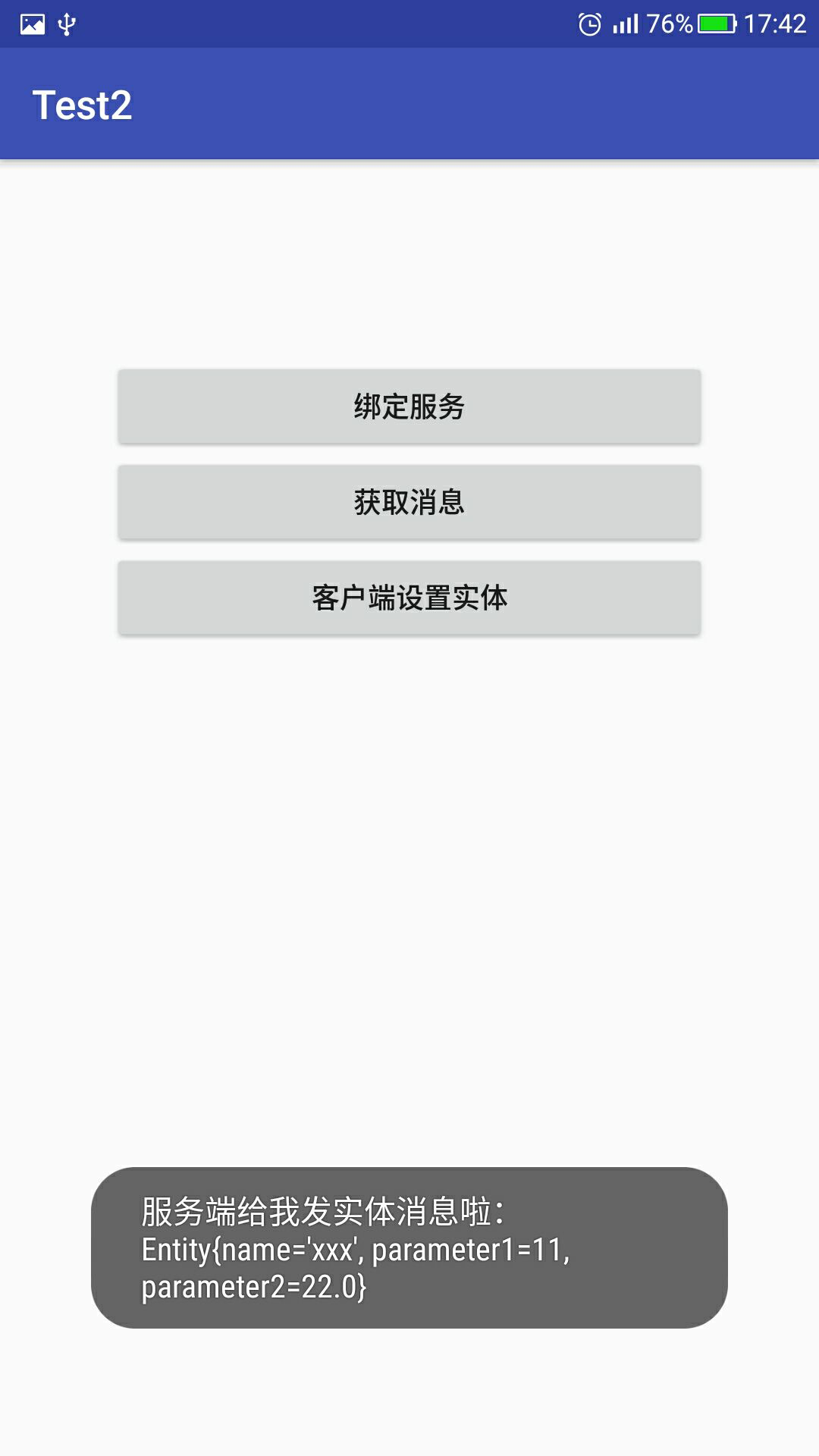AIDL 进程间通信的一个小小的总结
需求
项目需要,将做好的项目作为一个服务提供给另一个公司。我们需要提供一个apk,所以设计到进程间交互,不得不了解一下AIDL了。
了解一下AIDL
之前准备面试的时候,或多或少的了解了一点AIDL,不过现在忘记得差不多了。
所以网上随便找了几篇不错的文章。
一个简单的demo
自己搞了一个简单的demo。
实现了进程间通信,可以传输普通类型和实体类型。
首先是服务端。
1.第一个aidl接口。

// IMyAidlInterface.aidl package com.xf.test1; import com.xf.test1.IAidlCallBack; import com.xf.test1.Entity; // Declare any non-default types here with import statements interface IMyAidlInterface { /** * Demonstrates some basic types that you can use as parameters * and return values in AIDL. */ void basicTypes(int anInt, long aLong, boolean aBoolean, float aFloat, double aDouble, String aString); String getStr(String str); int getPid(); Entity getEntity(); Entity setEntity(in Entity entity); void registerCallBack(IAidlCallBack callback); void unregisterCallBack(IAidlCallBack callback); }
2.第二个aidl接口。

// IAidlCallBack.aidl package com.xf.test1; import com.xf.test1.Entity; // Declare any non-default types here with import statements interface IAidlCallBack { void callBack(String name); void callBackEntity(in Entity entity); }
3.第三个aidl接口。

// Person.aidl package com.xf.test1; parcelable Entity;
4.封装的一个IBinder。

package com.xf.test1; import android.app.Service; import android.content.Intent; import android.os.IBinder; import android.support.annotation.Nullable; public class AIDLService extends Service { private AIDLImp mBinder; @Override public void onCreate() { super.onCreate(); mBinder = new AIDLImp(this); } @Nullable @Override public IBinder onBind(Intent intent) { return mBinder; } @Override public void onDestroy() { super.onDestroy(); mBinder.KillAll(); } }
5.AIDL服务。

package com.xf.test1; import android.app.Service; import android.content.Intent; import android.os.IBinder; import android.support.annotation.Nullable; public class AIDLService extends Service { private AIDLImp mBinder; @Override public void onCreate() { super.onCreate(); mBinder = new AIDLImp(this); } @Nullable @Override public IBinder onBind(Intent intent) { return mBinder; } @Override public void onDestroy() { super.onDestroy(); mBinder.KillAll(); } }
6.实体类型。

package com.xf.test1; import android.os.Parcel; import android.os.Parcelable; /** * Description: 简单实体类 * * @version V1.0.0 * Createdate: 2018/6/22 * @author: wja 1211241203@qq.com */ public class Entity implements Parcelable { private String name; private int parameter1; private double parameter2; public Entity(String name){ this.name=name; } public Entity(String name, int parameter1, double parameter2) { this.name = name; this.parameter1 = parameter1; this.parameter2 = parameter2; } public int getParameter1() { return parameter1; } public void setParameter1(int parameter1) { this.parameter1 = parameter1; } public double getParameter2() { return parameter2; } public void setParameter2(double parameter2) { this.parameter2 = parameter2; } public String getName() { return name; } public void setName(String name) { this.name = name; } @Override public int describeContents() { return 0; } @Override public void writeToParcel(Parcel dest, int flags) { dest.writeString(this.name); dest.writeInt(this.parameter1); dest.writeDouble(this.parameter2); } protected Entity(Parcel in) { this.name = in.readString(); this.parameter1 = in.readInt(); this.parameter2 = in.readDouble(); } public static final Creator<Entity> CREATOR = new Creator<Entity>() { @Override public Entity createFromParcel(Parcel source) { return new Entity(source); } @Override public Entity[] newArray(int size) { return new Entity[size]; } }; @Override public String toString() { return "Entity{" + "name='" + name + '\'' + ", parameter1=" + parameter1 + ", parameter2=" + parameter2 + '}'; } }
7.清单文件。

<?xml version="1.0" encoding="utf-8"?>
<manifest xmlns:android="http://schemas.android.com/apk/res/android"
package="com.xf.test1">
<application
android:allowBackup="true"
android:icon="@mipmap/ic_launcher"
android:label="@string/app_name"
android:roundIcon="@mipmap/ic_launcher_round"
android:supportsRtl="true"
android:theme="@style/AppTheme">
<activity android:name=".MainActivity">
<!--<intent-filter>
<action android:name="android.intent.action.MAIN" />
<category android:name="android.intent.category.LAUNCHER" />
<data android:scheme="com.xf.aidl.test" />
</intent-filter>-->
</activity>
<service android:name=".AIDLService">
<intent-filter>
<action android:name="com.xf.aidl" />
<category android:name="android.intent.category.DEFAULT" />
<!--<action android:name="android.intent.action.MAIN" />-->
<!--<category android:name="android.intent.category.LAUNCHER" />-->
</intent-filter>
</service>
</application>
</manifest>
8.服务端如何运行(不使用启动图标的方式)

然后点击进去

9.最后点击运行,服务就安装在手机啦。
其次,是客户端。
1.客户端的aidl文件和服务端的完全一样。(当然路径可以不一样,为了方便我直接copy的,路径不一样也是可以的,测试过的)
2.然后注意实体类型所在的包一定要和服务端的一致,负责找不到这个实体的。
3.最后是客户端的主页面。

package com.xf.test2; import android.content.ComponentName; import android.content.Context; import android.content.Intent; import android.content.ServiceConnection; import android.os.Bundle; import android.os.IBinder; import android.os.RemoteException; import android.support.v7.app.AppCompatActivity; import android.util.Log; import android.view.View; import com.xf.test1.Entity; import com.xf.test1.IAidlCallBack; import com.xf.test1.IMyAidlInterface; import java.util.Random; public class MainActivity extends AppCompatActivity { private IMyAidlInterface mIMyAidlInterfaceService; private ServiceConnection mServiceConnection = new ServiceConnection() { @Override public void onServiceConnected(ComponentName name, IBinder service) { mIMyAidlInterfaceService = IMyAidlInterface.Stub.asInterface(service); try { mIMyAidlInterfaceService.registerCallBack(mIAidlCallBack); } catch (RemoteException e) { e.printStackTrace(); } } @Override public void onServiceDisconnected(ComponentName name) { try { mIMyAidlInterfaceService.unregisterCallBack(mIAidlCallBack); } catch (RemoteException e) { e.printStackTrace(); } mIMyAidlInterfaceService = null; } }; private IAidlCallBack mIAidlCallBack = new IAidlCallBack.Stub() { @Override public void callBack(String name) throws RemoteException { Log.e("info---->","服务端给我发消息啦:"+name); ToastUtil.showShort(MainActivity.this,"服务端给我发消息啦:"+name); } @Override public void callBackEntity(Entity entity) { Log.e("info---->","服务端给我发实体消息啦:"+entity.toString()); ToastUtil.showShort(MainActivity.this,"服务端给我发实体消息啦:"+entity.toString()); } }; @Override protected void onCreate(Bundle savedInstanceState) { super.onCreate(savedInstanceState); setContentView(R.layout.activity_main); } @Override protected void onDestroy() { super.onDestroy(); if (mServiceConnection != null) unbindService(mServiceConnection); } /** * 绑定服务 * @param view */ public void doClick(View view) { Intent intent = new Intent(); intent.setAction("com.xf.aidl"); intent.setPackage("com.xf.test1"); bindService(intent, mServiceConnection, Context.BIND_AUTO_CREATE); } /** * 获取服务器发送过来的消息 * @param v */ public void doAction(View v) { if (mIMyAidlInterfaceService != null) { try { String newstr = mIMyAidlInterfaceService.getStr("Hello world"); int pid = mIMyAidlInterfaceService.getPid(); Log.e("info---->", newstr + " pid:" + pid); } catch (RemoteException e) { e.printStackTrace(); } } } /** * 客户端自己设置实体,发送给服务端 * 通过随机数设置实体参数 * @param v */ public void doActionSetEntity(View v){ if (mIMyAidlInterfaceService != null) { try { Random random=new Random(); mIMyAidlInterfaceService.setEntity(new Entity("客户端",random.nextInt(100),random.nextDouble())); } catch (RemoteException e) { e.printStackTrace(); } } } }
下面是布局文件。

<?xml version="1.0" encoding="utf-8"?> <LinearLayout xmlns:android="http://schemas.android.com/apk/res/android" xmlns:app="http://schemas.android.com/apk/res-auto" xmlns:tools="http://schemas.android.com/tools" android:layout_width="match_parent" android:layout_height="match_parent" android:orientation="vertical" tools:context=".MainActivity"> <RelativeLayout android:layout_marginTop="100dp" android:layout_width="match_parent" android:layout_height="wrap_content"> <Button android:layout_width="300dp" android:layout_height="wrap_content" android:onClick="doClick" android:text="绑定服务" android:layout_centerInParent="true" /> </RelativeLayout> <RelativeLayout android:layout_width="match_parent" android:layout_height="wrap_content"> <Button android:layout_width="300dp" android:layout_height="wrap_content" android:onClick="doAction" android:text="获取消息" android:layout_centerInParent="true" /> </RelativeLayout> <RelativeLayout android:layout_width="match_parent" android:layout_height="wrap_content"> <Button android:layout_width="300dp" android:layout_height="wrap_content" android:onClick="doActionSetEntity" android:text="客户端设置实体" android:layout_centerInParent="true" /> </RelativeLayout> </LinearLayout>
运行效果是这样的:



这里客户端首先需要绑定服务
点击了获取消息:直接获取服务端创建好的实体类。
点击了客户端设置实体:通过产生随机数,客户端调用aidl接口设置实体。
如果再次点击获取消息:在服务端进行判断,如果客户端设置过实体,就把该实体发送回客户端。
demo地址:https://github.com/JasonToJan/AIDLDemo
个人小结
1.首先要理解aidl是干什么的:进程间交互。不同apk实现通信。
2.为什么可以做到进程间通信了,谁给两个进程之间搭起了一座桥梁呢?AIDL,其实就是一个接口,实现进程之间对接的功能。
3.两个进程要做到通信,aidl一定要保证一致,不然就是牛头不对马嘴了。
4.aidl如何实现数据传输了,binder。所以demo就把binder直接封装起来,基本所有逻辑都在这个封装类中进行即可。
5.再深入底层,binder是如何实现数据传输的呢?这就涉及到操作系统的知识了,binder处于一个内存共享区域,可以实现进程间通信。




